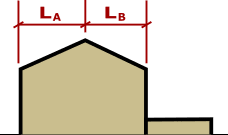I have a 4 on 12 gable roof sloped down to a 12' wide deck below. How should I figure out my snow drift? Particularly my upper roof fetch length? Is it the full width of the roof, eave to eave, or just the distance from the eave to the ridge? All of the examples I've seen are flat roofs with different levels.
Navigation
Install the app
How to install the app on iOS
Follow along with the video below to see how to install our site as a web app on your home screen.
Note: This feature may not be available in some browsers.
More options
You are using an out of date browser. It may not display this or other websites correctly.
You should upgrade or use an alternative browser.
You should upgrade or use an alternative browser.
Snow Drift from Gable Roof onto Deck
- Thread starter TAB_HOO
- Start date
- Status
- Not open for further replies.
jimstructures
Structural
TAB_HOO
Where is the building located? What is the appropriate building code for that location?
Jim
Where is the building located? What is the appropriate building code for that location?
Jim
ProgrammingPE
Structural
For the length of the roof upwind of the drift, lu, you can conservatively use the distance of the entire roof from eave to eave. The distance from ridge to eave would be unconservative since some snow will definitely make it over the ridge and contribute to your drift load.
It may also be a appropriate to use lu = 0.75*La + Lb (see the image below) due to some of the snow getting trapped on the leeward side of the roof. The commentary (C7.7 of ASCE 7-16) suggests using a procedure like this for stepped roofs. There is also an example in the "Guide to the Snow Load Provisions of ASCE 7-16" that is exactly like your question where they apply the same 0.75 factor to the windward side of a gabled roof in their snow drift calculation.

Structural Engineering Software: Structural Engineering Videos:
It may also be a appropriate to use lu = 0.75*La + Lb (see the image below) due to some of the snow getting trapped on the leeward side of the roof. The commentary (C7.7 of ASCE 7-16) suggests using a procedure like this for stepped roofs. There is also an example in the "Guide to the Snow Load Provisions of ASCE 7-16" that is exactly like your question where they apply the same 0.75 factor to the windward side of a gabled roof in their snow drift calculation.

Structural Engineering Software: Structural Engineering Videos:
- Thread starter
- #5
Thanks for the replies!
jimstructures: The building is a house in Bedford, Virginia. The appropriate code is the 2018 Virginia Residential Code (2018 International Residential Code with Virginia Amendments). Ground snow is 25 psf.
ProgrammingPE: I thought the eave to ridge distance would be unconservative for my upper roof fetch length (lu), but I also thought some of the snow might get trapped on the roof. The example you referenced in "Guide to the Snow Load Provisions of ASCE 7-16" is "FAQ 10", correct?
jimstructures: The building is a house in Bedford, Virginia. The appropriate code is the 2018 Virginia Residential Code (2018 International Residential Code with Virginia Amendments). Ground snow is 25 psf.
ProgrammingPE: I thought the eave to ridge distance would be unconservative for my upper roof fetch length (lu), but I also thought some of the snow might get trapped on the roof. The example you referenced in "Guide to the Snow Load Provisions of ASCE 7-16" is "FAQ 10", correct?
YoungGunner
Structural
I love the response from ProgrammingPE, something I will think about a bit more. Up to this point in time, I've concluded that I would use the entire length of the roof unless the roof pitch was greater than 7:12, similar to the point when unbalanced snow loads need not be considered. Once it exceeds 7:12, I've concluded that if ASCE isn't worried about snow load blowing from one side to the other then we wouldn't need to include the full length of the roof for lower drift.
ProgrammingPE
Structural
Yes, "FAQ 10" in "Guide to the Snow Load Provisions of ASCE 7-16" appears to be identical to what you are describing.
- Status
- Not open for further replies.
Similar threads
- Locked
- Question
- Replies
- 2
- Views
- 9
- Locked
- Question
- Replies
- 5
- Views
- 6
- Question
- Replies
- 3
- Views
- 8
- Replies
- 4
- Views
- 7
- Locked
- Question
- Replies
- 5
- Views
- 16
